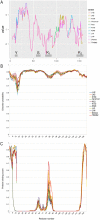Genetic diversity at the Dhn3 locus in Turkish Hordeum spontaneum populations with comparative structural analyses
- PMID: 26869072
- PMCID: PMC4751488
- DOI: 10.1038/srep20966
Genetic diversity at the Dhn3 locus in Turkish Hordeum spontaneum populations with comparative structural analyses
Abstract
We analysed Hordeum spontaneum accessions from 21 different locations to understand the genetic diversity of HsDhn3 alleles and effects of single base mutations on the intrinsically disordered structure of the resulting polypeptide (HsDHN3). HsDHN3 was found to be YSK2-type with a low-frequency 6-aa deletion in the beginning of Exon 1. There is relatively high diversity in the intron region of HsDhn3 compared to the two exon regions. We have found subtle differences in K segments led to changes in amino acids chemical properties. Predictions for protein interaction profiles suggest the presence of a protein-binding site in HsDHN3 that coincides with the K1 segment. Comparison of DHN3 to closely related cereals showed that all of them contain a nuclear localization signal sequence flanking to the K1 segment and a novel conserved region located between the S and K1 segments [E(D/T)DGMGGR]. We found that H. vulgare, H. spontaneum, and Triticum urartu DHN3s have a greater number of phosphorylation sites for protein kinase C than other cereal species, which may be related to stress adaptation. Our results show that the nature and extent of mutations in the conserved segments of K1 and K2 are likely to be key factors in protection of cells.
Figures




References
-
- Zohary D. & Hopf M. Domestication of plants in the Old World. The origin and spread of cultivated plants in West Asia, Europe and the Nile Valley. Clarendon Press, Oxford, England (1993).
-
- Badr A. et al. On the origin and domestication history of barley (Hordeum vulgare). Mol. Biol. Evol. 17, 499–510 (2000). - PubMed
-
- Knüpffer H., Terentyeva I., Hammer K., Kovelava O. & Sato K. Ecogeographical diversity – a Vavilovian approach in Diversity in barley (Hordeum vulgare), (eds von Bothmer R. et al.) 53–76 (Elsevier, 2003).
-
- Forster B. P. et al. Locating genotypes and genes for abiotic stress tolerance in barley: a strategy using maps, markers and the wild species. New Phytologist. 137, 141–147 (1997).
-
- Nevo E. & Chen G. Drought and salt tolerances in wild relatives for wheat and barley improvement. Plant Cell Environ. 33, 670–685 (2010) - PubMed
Publication types
MeSH terms
Substances
LinkOut - more resources
Full Text Sources
Other Literature Sources

